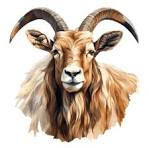Role of National and International Agencies in Conservation of Markhor.
With special approval of CITES, the KPK WD launched the community based markhor trophy hunting program in the Province in 1997. This program was launched to encourage nearby communities and their role in the protection of Markhor and other wild species. For this 80% of the permit fee has to be placed into a Village Conservation Fund (VCF). This program worked effectively to change the point of view of locals. The KPK ought to get acknowledgement for this accomplishment since nearby occupants effectively participated in the security of markhors. In 1992, CITES moved all Capra falconeri subspecies and populations from Appendix II to Appendix I. In 1997, theConference of Parties to the Convention on InternationalTrade in Endangered Species (CITES) issued a resolution permitting an annual export limit of six Markhor trophies from Pakistan's community-based hunt market sectors to CITES-accredited countries.
Wildlife Conservation Society.
The WCS community-based conservation programme has been a huge success in saving Markhor and restoring them to a place of pride (as well as ecological and economic value) in Gilgit-Baltistan. Since 1997, WCS has been working in the heart of the are-horned Markhor distribution. Illegal hunting and harvesting have ceased in most of the valleys where WCS trained community rangers are working as a result of this programme. The rangers' wildlife tracking has also revealed that the Markhor population is increasing: the initial survey gave roughly an estimate of 1700 Markhor in the programme landscape, representing a 70 percent rise in the population from year 2000 to next 2 years. The WCS Pakistan Program now touches 65 villages in Gilgit-Baltistan, influencing over 400,000 inhabitants, and covering approximately 80% of the Markhor territory. In several of these valleys, Wildlife Conservation Society is the sole animal protection NGO working full-time.
Conservancy by the Parks and Wildlife Department Gilgit Baltistan
Markhor are also tracked and safeguarded by a new programme called "Markhor conservancy". The agencies shared the benets of conservation with the locals. In 2014, a study was conducted in Jutial Conservancy, District Gilgit, and Gilgit-Baltistan, to determine the rank of the are-horned Markhor (Capra falconeri falconeri). The findings of the survey revealed the existence of 162 adult Markhor, with a number of kids. The study's findings further support the preservation interventions, particularly the trophy hunting programme launched in the Conservancy by the Parks and Wildlife Department Gilgit-Baltistan and the Wildlife Conservation Society, as a successful example of community-based Markhor preservation in the region that can be replicated in other parts of the species' range for joint management of Markhor and other natural resources, as well as to improve local populations' livelihoods.
Funding for Conservation of Markhor
In 1997 Markhor prize hunting program was initiated by the special permission of CITES. The purpose of this program was to advance nearby networks in the protection of Markhor and other significant creature species. The 80% of the permit fee was to deposit into Village ConservationFunds (VCF). The viewpoint of the program was achieved by involvement of locals that produced significant impact to save the lives of wild animals along with others. A prompt expansion in the quantity of Markhor in local areas was noticed in the protection regions. Later, the VCF was used to improve the infrastructure such as repairing of roads, introduction of small water supply channels etc. This was only accomplished by locals as they partook effectively in the security of these assets. TCP, and Community based conservation and management of mountain ungulates in Tajikistan are some more projects that are working for the conservation of Markhor.



Comments
Post a Comment